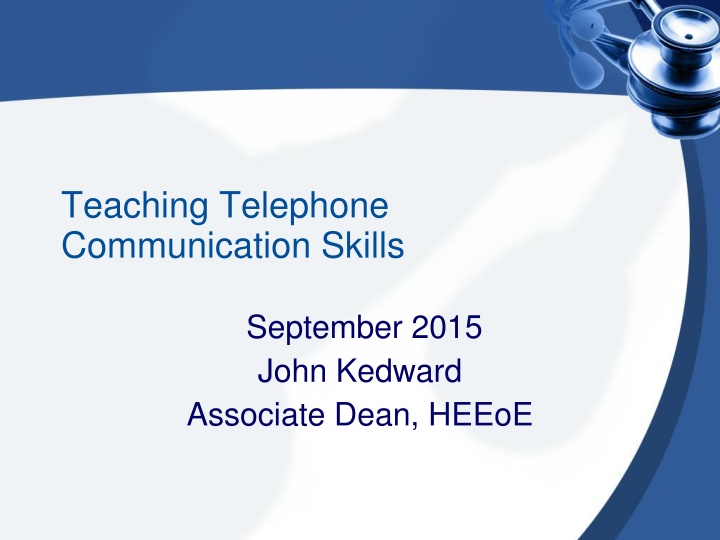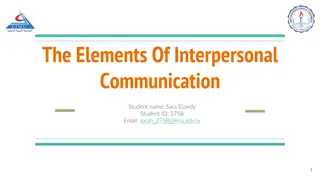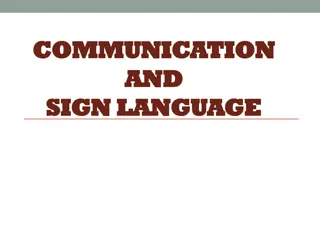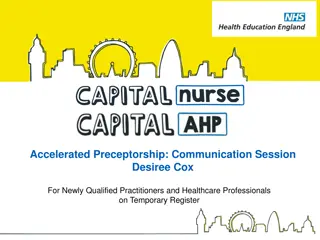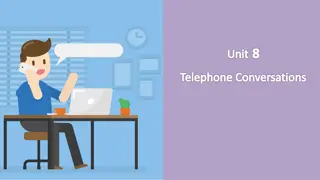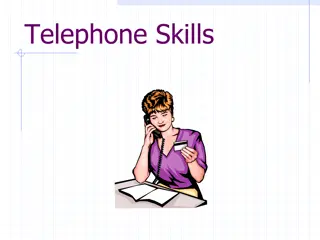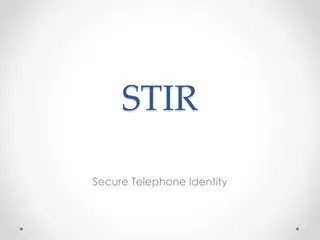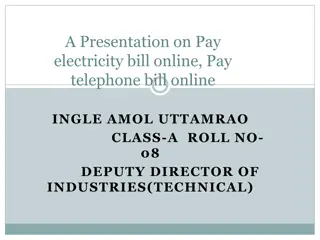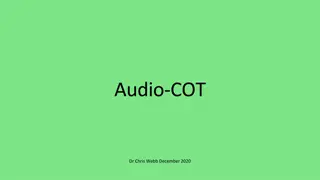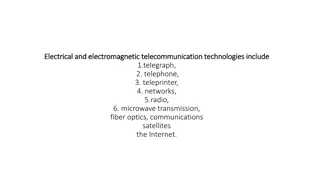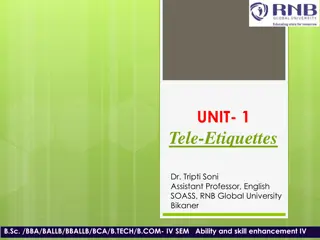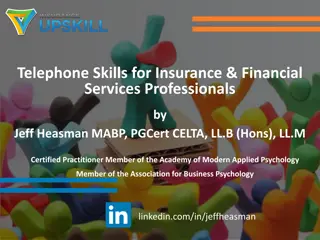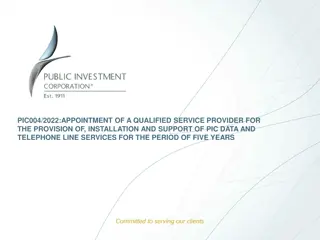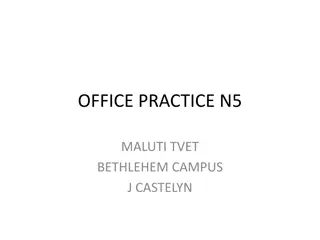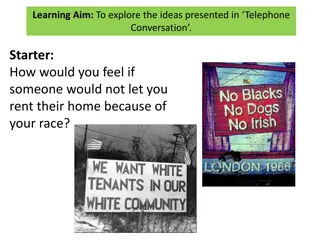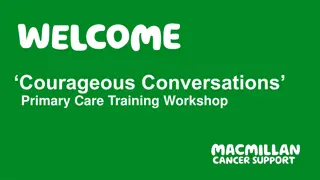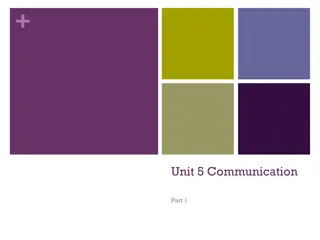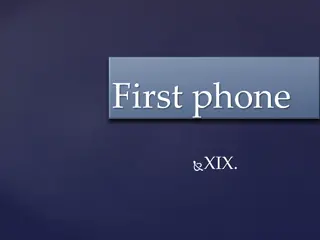Mastering Telephone Communication Skills Workshop Series
Enhance your telephone communication skills with a comprehensive workshop series covering teaching methods, group work strategies, and modules focusing on introduction, assessment tools, and role plays. Explore key considerations for planning, engaging with various learner groups, and optimizing learning outcomes. Gain practical insights into structuring consultations, assessing quality, and role-playing scenarios for effective skill development.
Download Presentation

Please find below an Image/Link to download the presentation.
The content on the website is provided AS IS for your information and personal use only. It may not be sold, licensed, or shared on other websites without obtaining consent from the author.If you encounter any issues during the download, it is possible that the publisher has removed the file from their server.
You are allowed to download the files provided on this website for personal or commercial use, subject to the condition that they are used lawfully. All files are the property of their respective owners.
The content on the website is provided AS IS for your information and personal use only. It may not be sold, licensed, or shared on other websites without obtaining consent from the author.
E N D
Presentation Transcript
Teaching Telephone Communication Skills September 2015 John Kedward Associate Dean, HEEoE
What to consider when planning teaching of telephone comms skills Type of learner(s) Learning needs of the learner(s) Expertise of the teacher Resources you may need Number of learners 1:1 or group Context of telephone assessment Why is it a separate skill? How are changes in service delivery affecting telephone competencies?
Group work In groups of three consider different ways of teaching telephone consultation skills Identify a learner group Plan a workshop session Consider pros and cons of each method used What resources would help you?
Modules to consider The methods used to teach will depend on the number of trainees and the time available. One day can cover a lot Half a day can cover most Less likely to achieve much with one hour session, unless repeated
MODULE ONE: INTRODUCTION Key objectives Understand what is different about telephone consultations and the implications of this. Provide a structure and a model for learners to use to ensure key tasks completed. repeated. Structure/ models -telephone assessment Methods Presentation plus group work with plenary feedback Duration One hour
MODULE TWO: ASSESSMENT TOOLS Key objectives: To understand how to assess the quality of different aspects of telephone consultations To practice using the tools with benchmarked audio recorded telephone consultations Benchmark and compare scores in small and large groups, understand why score differently and reflect on what that means about own gaps. Methods Presentation and explanation of one or more tools how to score, what scores mean? Listen and score some good, average less good calls Plenary benchmarking and comparing scores Duration 90 minutes or more
MODULE THREE: ROLE PLAYS Key objectives To practice doing telephone consultations in a supported way with scenarios, where your role plays are objectively assessed and you are given developmental feedback Methods Option of using professional role players/ learner role players, use an additional observer Rotate role and practice several role plays Small group feedback Large group plenary Duration 60 minutes or more
MODULE FOUR: TOP TIPS & ADVANCED SKILLS Key objectives: To learn what works well and where the pitfalls are from experience of others, from significant events, etc Methods Presentation & group discussion Significant event presentation, or audio file Group discussion of lessons learned Role playing different approaches to challenging scenarios Duration One hour or more
MODULE FIVE: ONLINE VIRTUAL PATIENT SCENARIOS Need permission and login Pilot Project HESW Seven modules different login for trainer and trainee Focussed on different aspect of emergency care and OOH care Supports curriculum assessment in emergency care and OOH care http://uchoose.uwe.ac.uk/Player/Play Suitable for 1:1 and self-directed learning
Options for rest of session Listen to call and score it. Do a role play
Telephone consulting is the most difficult and challenging aspect of General Practice. I work hard to get it right and do it well. (GP of 20+ years experience and a trainer)
Differences between telephone and face-to-face consultations - FLIPCHART
face to face vs telephone Opportunity to examine Body language / physical pointers Easier to communicate when have all other aspects (visual contact etc.) Harder to avoid the problem Easier to establish rapport & empathy Can observe other aspects (social / family) ? Encourages dependence on face to face contacts whereas advice may encourage self- reliance
telephone vs face to face History only No previous relationship No knowledge of PMH Not necessarily talking to patient More difficult to establish rapport Easier to put people off Easier to push dr's agenda Difficulties of being recorded (this changes the very nature of the consultation)
telephone vs face to face More difficult to assimilate information Difficulty interpreting symptoms & signs Deal with a greater workload Easier when patients only want reassurance May speed decision making in acute situations Patient expectation - people expect visits Misunderstandings may occur Difficulties less if own dr. What if no phone?
Differences between telephone and face-to-face consultations Words clarity more important Tonality affected by sound quality Body language - invisible
Stages of a telephone consultation achieving a high quality outcome
Quality in telephone consultations 1. Identifies reason for presentation A. Elicits reason for presentation B. Responds to cues C. Elicits relevant information to place presentation in context D. Explores and uses health understanding E. Obtains sufficient information to assess whether immediate action indicated 2. Defines problem A. Obtains additional relevant information including PMH and red flags B. Obtains DH [including allergies] C. Makes an appropriate assessment of physical and mental state D. Shows evidence of hypothesis generation E. Arrives at an appropriate working diagnosis or disposition
Quality in telephone consultations 3. Shares problem A. Discusses proposed management (and options where appropriate) with patient B. Defines mutually agreed management plan 4. Manages problem A.Management plan is appropriate to working diagnosis and reflects good practice wherever possible B. Makes appropriate use of resources (referral, other professionals etc.) C. Demonstrates appropriate prescribing behaviour
Quality in telephone consultations 5. Ends Consultation A. Demonstrates appropriate use of time B. Clearly defines symptoms/ signs/ triggers for further consultation (safety netting) C. Confirms patient s understanding of safety netting D. Accurately records all relevant data
Stages of a telephone consultation HANDOUT 1. Preparation 2. Introductions 3. Gathering information 4. Diagnosis/ decision making 5. Action plan 6. Concluding the call
1. Preparation Any information available previous consultations, results, Check records Pre-plan what consultation might be about (if information is clear)
2. Always introduce yourself by name and mention your organisation. If the caller is not the patient, why not- establish/confirm the identity of the caller and relationship to the patient (and consider any implications for confidentiality). Try to speak directly to the patient if possible/appropriate. A first hand history tends to be more reliable although there are clearly situations when an additional history from a third party will be valuable. Introductions
2. Introductions Establish trust and rapport Empathise - few patients, no matter how offhand they seem, take the decision to call lightly. An initially prickly, demanding manner may be fuelled by anxiety, so empathise when you take the call, e.g.: "I hear (x) has a nasty sore throat, tell me all about it".
2. Introductions A second call for the same patient within a short time frame often requires a more careful and thorough triage as statistically it is more likely to indicate a more significant clinical problem which requires a face to face consultation.
3. Gathering information Start with open questions Listen to the caller and give enough time to place yourself in a position to assess what they are saying. Allow the caller to give their own account of the problem in their own words with the minimum of interruptions. Focus on clinical aspects only when you have established: the reason(s) for the call; and the callers ideas, concerns and expectations
3. Gathering information The 5 'W's are useful guides: What is the problem? Where does the problem occur? When does the problem happen? What makes the problem better or worse? What is the timeframe for the problem?
3. Gathering information Open and closed questioning Avoid repetition as this diminishes the confidence of the caller. Deliver questions/information in a clear manner, without 'waffling or padding' or 'beating about the bush'. Establish caller's agenda Establish callers ideas, concerns, expectations Summarise and check understanding
4. Diagnosis/ decision making Making a differential diagnostic map (consider the important not to miss diagnoses even if unlikely) Flexible approach to decision making options will exist which are safe and acceptable?
5. Action plan Empower caller to take action where possible involve in decision making Negotiation Clarify what action you will take Check understanding Plan agreed
5. Action plan Possible outcomes: i. Information or advice only is required ii. A face to face consultation with a GP or a nurse is necessary at home, in the surgery, out of hours centre iii. A consultation with others is needed (999 Ambulance, A&E, Community Nurse referral, Social services)
RCGP SCORESHEET Listen to these calls and score them Discussion
What defines excellence in telephone assessment? Advanced Telephone Communication Skills
What is required in good Telephone Assessment Good Telephone Assessment requires; Training, because it requires/needs; Skill Structure Techniques Critical thinking Practice Expert communication skills Symptom assessment is rarely cut and dried, and evaluating patients without being able to see them presents the fundamental challenge of telephone management.
What is required in good Telephone Assessment Acknowledge that it comes more easily for some than for others due to; Personality Confidence Voice Experience A number of studies have identified substantial variation in the quality of telephone consultations/assessments
Callers/patients expectations Caller s have expectations and what they want generally: to know who they are speaking to to get a timely response empathy and recognition of their anxiety and recognition of their concerns empowerment to deal with and to know what they can do about, their problem to know what to do if things change / get worse
Telephone Consultation What makes a good consultation? Identify yourself CLEARLY by name and the organisation you work for. Apologise if there is delay in response Start with an open question: How can we help you? What s been happening with .. What s the situation with .. What can we do for you .. Or I understand that you are experiencing a fever/diarrhoea/back pain Open early with an empathic / empathetic tone I m led to believe that your are concerned about your child Jade/ Kylie etc
Telephone Consultation Etiquette : what makes a good consultation? Use active listening. Make yourself interested. Concentrate on their words not your ideas. Use mmm s, ahaa s and empathetic ahhh s as appropriate Pick up on cues, reflect these back with a question Use open questions : How, What, Where, When, Which Use Why carefully or avoid it. Allow the caller to voice their concerns & acknowledge their concerns Enhance by clarifying and summarising
Structure Use the toolkit as a guide .i.e Elicit call reason Identify emergency SX PMH, DH Assessment Management Prescribing Safety netting Rapport
Problem and Patient History Using SCHOLAR for problem history Symptoms and associated symptoms Is it an isolated symptom or complex of symptoms? Course of symptoms: Is it better? Worse? The same? Characteristics (aids in precise description) Quantitative (scale of 10) Qualitative (sharp, dull, pounding) History of complaint In the past: What was done? By whom? When? Results? Onset of symptoms When started? How long present? Sudden or gradual? (Sudden = higher acuity) Location of symptoms: Strive for precision. Radiation? (localized = higher acuity) Aggravating factors What makes it worse? Relieving factors What makes it better?
Pitfalls in telephone consultation; where things go wrong Bad openings, yawn, Hi it s the OOH doctor here Interrupting the patients story / narrative Not finding out why they have called and their concerns Making an assumptions early in as to what is wrong with the patient and what the outcome is going to be Not sounding confident Lacking focus
Common Pitfalls The most common of these pitfalls include; Inadequate time taken on the call Insufficient history taking and documentation Stereotyping of clients and problems Second guessing or over-reliance on callers Premature closure
Stereotyping We can avoid stereotyping symptom patterns by careful and sensitive assessment of problem and patient history, and by taking care not to jump to conclusions. For example, burning on urination in an older female cannot simply be dismissed as a urinary tract infection; it may be symptomatic of a sexually transmitted disease.
Assumptions Being dismissive of the caller's concerns Callers who claim that the problem is an emergency may have correctly assessed the situation
Assumptions The caller who has self-diagnosed a problem may give a false sense of security. For example, the caller who begins by saying: "My new medication makes me feel dizzy" or "I was carrying some logs and now my shoulder really hurts" or "I think I have the flu" may have seriously misrepresented the problem. The initial patient description must be set aside and more details are elicited You cannot simply assume that symptoms are a result of a medication, musculoskeletal injury, or the flu. Those complaints could be related to conditions like stroke, myocardial infarction, or sepsis, for example.
Eliciting the relevant, pertinent and significant information Salience is defined as being particularly noticeable, striking or relevant A major task in telephone assessment is to determine what data are relevant and which are not While key symptoms may be salient, others that are more general and nonspecific may be given less weight. There will be information that is irrelevant and must be consciously ignored in order to come to safe decisions. Experts have found that too little or too much information impairs critical thinking
